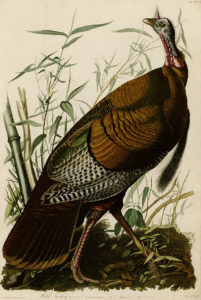 Print this Article
Print this Article

Identifying a bird species as Kosher
Adapted by Rabbi Ariel Ovadia[1]
The No-Eat List
The Torah in Parashat Shemini and Re’eh identifies 24 species of non-kosher birds. Based on the Gemara, Maran rules[2] that if one can identify these 24 forbidden types of birds, one can eat any bird that is not on the list. However, it seems like even in the time of the Hachamim of the Gemara there were uncertainties as to the exact identity of these species.
Fortunately, the Gemara in Hullin[3] provides a list of the identifying features of kosher birds: they are not scavengers (feed on dead animals), they have a crop (a part of the digestive system), a gizzard with a thin layer that can be peeled, and an extra toe. A kosher bird on a wire will have three toes in front and one in back. The eggs of kosher birds are identifiable in that one end is narrower than the other.
Aside from the various discussions in the Poskim about the details of this Gemara, the accepted custom is to only eat a bird if there is a Mesora – tradition – that it is kosher. To establish a reliable Mesora, one would have to track down a Shohet who was acquainted with the species and would slaughter it in the old country.
A Turkey Tradition
The big problem with this is that many birds were simply not found in the Old World. The most famous example is turkey, which is native to the Americas and was introduced to Europe in the 16th century. Despite having all the identifying features of a kosher bird listed in the Gemara, it would seem impossible to establish a Mesora to eat turkey prior to its discovery[4].
Nevertheless – based on the Kenesset HaGedola – the Kaf HaHayim and Zivhe Tzeddek write that there was a Mesora to eat it in Baghdad, and, the Magen Avot writes, this too was the custom in Morocco. The Sho’el U’Meshiv writes that it may be that because it became so widely accepted to eat it for so many generations by the entirety of the Jewish world, that a pre-established Mesora is not required in the case of turkey.
The Magen Avot adds that perhaps, according to Maran, a bird that has wide feet and a wide beak may not require a Mesorah. Thus, the turkey would be permitted despite its lack of Mesora prior to the 16th century.
The Halachic Classification of Species
This brings us to another discussion. While many species may have a general Mesora, they tend to vary slightly from place to place and the question would become whether they should be considered the same species or a different species. For example, ducks have a Mesora, but are all the species that are classified by zoologists as duck considered a duck in Halacha?
While most of these varieties of birds are not consumed by the general population, a more practical reason to research these species would be for the consumption of their eggs. For example, quail eggs or exotic duck eggs are a useful alternative for those with allergies to chicken eggs.
The late Poskim seem to maintain that if a bird is virtually identical to another with a Mesora but has only one differentiating characteristic, for example one is small and the other is big, then it can be considered one species. This would depend however on how close you look. Most variations would have more than one difference if you look closely. For many years, the OU would consult in these matters with the Ga’on, Rav Chaim Yisrael Belsky זצ”ל. Be’Ezrat Hashem, in a future article, we will bring some examples of birds that have or continue to be a source of controversy in Halacha.
Sources:
[1] Based on a Shiur by Rabbi Chayim Loike, bird specialist for the OU, Sefer Magen Avot of Rav Mordechai Lebhar and other sources.
[2] Y.D. 82
[3] 49a
[4] The Shut Mei Be’er even suggests that it is called “Hodu” in Hebrew (India) and that the Jews of India must have had a Mesora to eat it.